UNIT 4
Microwave Measurement
The measurement parameters and techniques used for analyzing the circuits (or networks) are different at low and microwave frequencies. At low frequencies, the entire circuit is affected by the voltage and current waves at the same time. Thus the circuit elements are lumped. It is convenient to measure current and voltage and to use them to calculate power at low frequencies. However, at high frequencies, it is convenient to describe a given network in terms of voltage waves and current waves rather than voltage and current, because they vary with position in a transmission line (or waveguide). At microwave frequencies, most of the quantities measured are relative, not absolute as in low-frequency measurements. And it is also not necessary to know their absolute values at microwave frequencies. The parameters that can be conveniently measured at microwave frequencies are frequency, power, attenuation, VSWR, impedance, and Cavity Q.
Microwave measurements can be done by either direct measurement or by indirect measurement. Indirect measurements are carried out by modulating the microwave signal by 1 kHz square wave signal. These measurements are low cost but labour and time intensive and require a lot of care while taking measurements to avoid errors. Direct measurements require expensive instruments like network analyser, spectrum analyser, power meter and noise figure analyser. These instruments are highly accurate and less time consuming as they directly measure the parameters like return loss, VSWR, power, frequency and noise figure.
Power at low frequencies is similar to the Microwave power; in the way that is, it is the product of rms voltage, rms current, and power factor.

Depending on the power level, there are three different measuring techniques:
Measurement of low power (0.10 mW–10 mW)–Bolometer technique Measurement of medium power (10 mW–1 W)–Calorimetric technique Measurement of high power (1 W–10 W)–Calorimetric watt meter
Measurement of low power (Bolometer technique) :
Devices that are capable of measuring low microwave powers are bolometers and thermocouples, whose resistance changes with the applied power. Among these, bolometers are the most widely used. A bolometer is a device that converts RF power into heat, and this changes its resistance, from which power can be measured. There are two types of devices, namely barretters and thermistors, which are useful in the absolute measurement of power.
A barretter consists of a short length of very fine platinum wire that is suitably capsulated. These are positive temperature coefficient (PTC) components, and their resistance increases with an increase in temperature. Thermistors are semiconductor materials. These are negative temperature coefficient (NTC) components, and their resistance decreases with an increase in temperature.
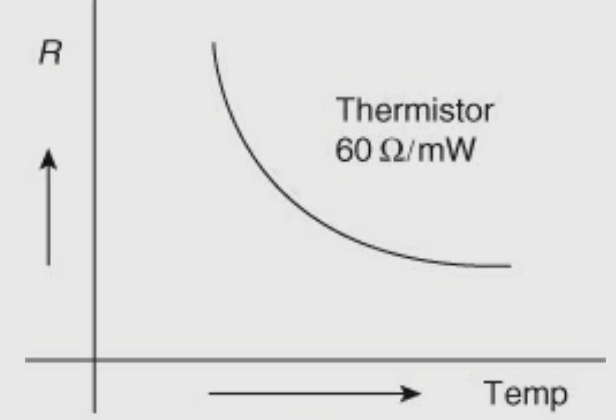
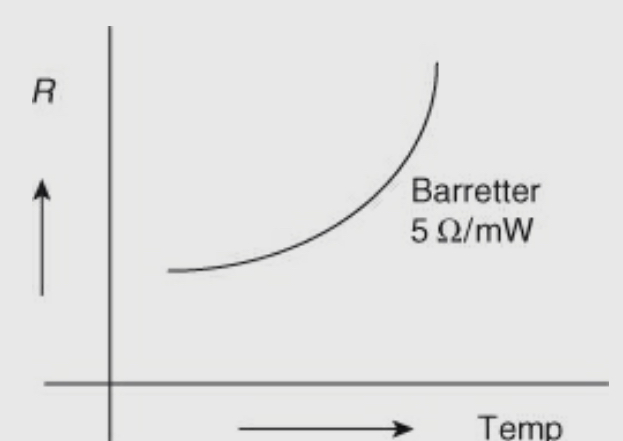
A bolometer is a square-law device, similar to a crystal diode. It produces a current that is proportional to the applied power, that is, the square of the applied voltage, rather than the applied voltage. A bolometer is placed inside the waveguide, where the bolometer itself acts as a load with R1 Ω as operation resistance. Now, low microwave power is applied that is to be measured. Bolometer load absorbs some of the power applied and dissipates it as heat, and its resistance changes to R2 Ω. This change in resistance (R1 ~ R2) is proportional to the microwave power that can be measured using a bridge. Due to non-linear characteristics of the bolometer inaccuracy is introduced.
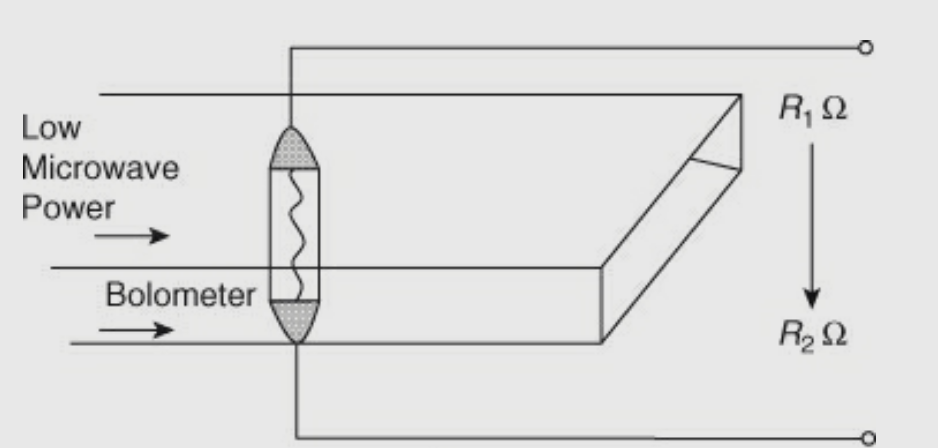
The bolometer itself becomes one of the arms of the bridge, in the balanced bolometer bridge technique. At first, R5 is adjusted so that the bridge is balanced. This changes the dc power applied to the bridge, and the bolometer element is brought to pre determined operating resistance before the microwave is applied. Let the battery voltage at balance be denoted by E1.The microwave power applied is dissipated in the bolometer. The bridge becomes unbalanced due to the change in resistance which is due to the heating of bolometer. To balance the bridge again, the applied dc power is changed to E2. This change in dc battery voltage (E1 ~ E2) is proportional to the microwave power. Alternately, the detector “G ” can read the microwave power directly, by balancing the bridge. This balancing of the bridge can be achieved by calibrating the detector in terms of microwave power. However some errors can occur which can be avoided by temperature compensation, since the bolometer is a temperature sensitive device. This can be achieved by using R6 and R7 resistors.

Limitations: Power-handling capability of barretters and thermistors are limited to about 10 mW. So, higher powers (> 10 mW) cannot be measured with them directly.
Measurement of medium microwave power :
The range of medium microwave power is from 10 mW to 1 W. The power in this range can be measured by calorimetric techniques. The principle of calorimetric technique is that a special load which is monitored, is proportional to the power responsible for the rise. The special load should have high specific heat. Generally water is a good load. The power can be measured by knowing mass, specific heat, and temperature rise at a fixed and known rate of fluid flow.

Measurement of high microwave power :
Power between 1 W and 10 W can be considered high microwave power. These are usually measured by calorimetric watt meters. In this method also, the temperature rise of a special load is monitored to measure the microwave power. A microwave calorimeter watt meter consists of two identical temperature-sensitive gauges, one in each arm, and an amplifier with high gain. The bridge is imbalanced as the input sensing resistor heats up. This heating up of the input sensing resistor is due the microwave power that is incident on the calorimeter. The circulating stream of either oil or ammonia gas is the dissipative load. By amplifying and applying the imbalance signal of the bridge to the comparison resistor and using the power delivered to it the bridge can be rebalanced. The watt meter keeps the record of the microwave power.

VSWR stands for voltage standing wave ratio. In a perfectly matched system, there is no variation in the field strength along the waveguide. A mismatch leads to reflected waves, thereby leading to standing waves along the length of the guide. Standing waves are the indication of the quality of the transmission. VSWR = 1 for a perfectly matched system. The ratio of the maximum to the minimum voltage gives the VSWR.
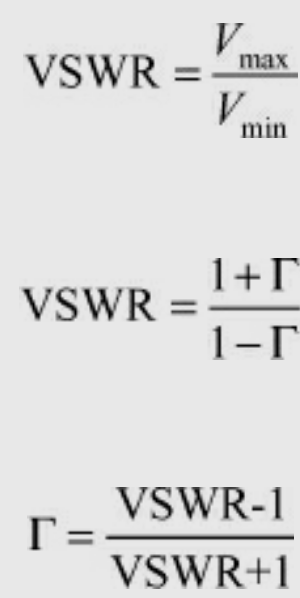
Where Γ is the reflection coefficient.
A typical setup for VSWR measurement is shown in the figure below,

Measurement of Low VSWR (S < 10) :
VSWR values below 10 are very easily measured by this method. The VSWR meter directly displays these values. The setup is shown in the figure above. The attenuator is adjusted to give a maximum reading on the meter. The attenuation has to be adjusted to get a full-scale reading. Then, the minimum reading on the meter is obtained by adjusting the probe on the slotted line. Thus the VSWR is defined by the ratio of the firstreading to the second reading. The meter can be calibrated in terms of VSWR. Here, attenuator is adjusted so that the traveling probe gives a maximum deflection on the VSWR meter. The VSWR of 1 corresponds to full-scale deflection (i.e. 10 mV in the meter). By adjusting the traveling probe the minimum reading can be obtained on the meter.
Measurement of High VSWR (S > 10) :
VSWR greater than 10 can be measured by double minimum method. In this method, the probe is inserted to a depth where the minimum value can be read easily. Then the probe should be moved to a point where the power is twice the minimum ( ). Let be this position. Then again, the probe is moved to twice the power point on the other side of the minimum (say ) as shown in figure below,
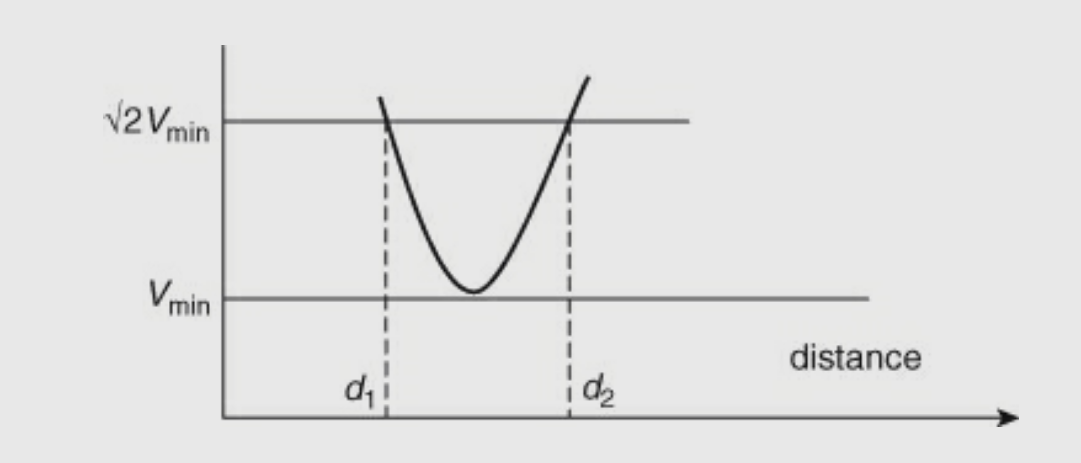
Impedance (Z) is defined as the ability to oppose the flow of an alternating current (AC ) at a given frequency. It is represented as a complex quantity and is graphically shown on a vector plane. An impedance vector consists of a real part (resistance, R) and an imaginary part (reactance, X ).


There are many methods for measuring impedance, each of which has advantages and disadvantages. The most commonly used method is the measurement of impedance using the slotted line.
Measurement of Impedance Using a Slotted Line :
The end of the slotted line is connected to the unknown impedance. From the other end of the coaxial line microwave power is fed. A part of the power is reflected by the unknown impedance. By evaluating the standing wave fields in the slotted line this reflection coefficient is measured. The reflection coefficient Γ, is given by

Where, the unknown impedance terminating a line of characteristic impedance is . Thus, can be determined, if Γ is measured and is known. As is complex, from the VSWR measurement both the magnitude and phase of Γ can be determined.


VSWR and ( difference of two successive minima) are noted by moving the probe and observing the output on a VSWR meter. Knowing the VSWR and a graphical construction on Smith chart may be used to calculate the unknown impedance .
Microwave frequency can be measured by two methods:
(i) slotted-line method;
(ii) electronic technique.
Slotted-line Method (Mechanical Technique) :
In this method, the measurement of wavelength in a waveguide will be made first and from that, frequency will be determined. A tunable resonator is required for this method, which has a known relation between a physical dimension and frequency, for example an absorption wave meter. The standing wave pattern appears only when the slotted line is terminated by a short circuit. The positions of two adjacent nulls are accurately positioned in two steps (i) moving the probe along a slotted line (ii) read the position of nulls in the vernier scale. The two positions are separated by half a guide wavelength λg/2.
The free space wavelength is given by,

The guided wavelength in the air-filled rectangular waveguide, is given by,

And


The distance between two successive voltage minima is given by
λg/2 = (d2 − d1).
The cutoff wavelength, λc = 2a (for the dominant TE10 mode), where “a” is the broad dimension of the waveguide Therefore,

(where c - speed of light in free space (3 × l08 m/s)
f – frequency, (Hz)
λ 0 – wavelength in free space, (m)
λ g – wavelength of waveguide, (m)
λ c – cutoff wavelength of waveguide (m)
In this method, the guided wavelength (λg) in a waveguide is measured by creating standing waves in a slotted-line section. The distance between a maxima and minima of the standing wave (d2 – d1) corresponds to (λg/2); hence, frequency can be determined from the measurement of (λg).
Electronic Technique :
This method uses frequency heterodyne system. This system compares the unknown microwave frequency with a harmonic of the known standard frequency. The unknown frequency f can be calculated as below from the output frequency fand frequency nf by stating that,


Attenuators are used to adjust the power level of the microwave signal. If the network is perfectly matched, the reflected power is zero and the insertion loss is similar to the attenuation provided by the microwave device or component. Attenuation is defined as the ratio of input power to the output power in dB.

Where P1 = power detected by the load without the attenuator in the line, P2 = power detected by the load with the attenuator in the line.
Measurement of attenuation is done in two ways: (i) power ratio method; (ii) RF substitution method.
Power Ratio Method :

Power ratio method is a process of measuring the input and output power with the device (set up 1) and without the device (or attenuator) in the circuit. The P1 and P2 are the powers measured in setup 1 and 2. The attenuation is the ratio of power (P1/P2) which is expressed in decibels.
(a) Setup 1 power ratio method without the device or attenuator
(b) Setup 2 power ratio method with the device or attenuator
Disadvantage of the power ratio method : The attenuation calculated will not be accurate, particularly if it is large. Because the two powers measured (P1 & P2) is non-linear. It is also true for the networks with low input power. With this method, we can measure the attenuation up to 20 dB only.
RF Substitution Method :
The attenuation through the device under test is compared with a standard microwave attenuator operating at the same frequency in this method. The network whose attenuation is to be measured is included in the setup 1. Thus the output power “P ” is measured by this method. The drawbacks of the power ratio method can be overcome by this method as the attenuation is measured at a single power position. A precision calibrated variable attenuator replaces the network in setup 2. This attenuator is adjusted to get same output power “P,” as in setup 1. Under this condition, attenuation of the device is to be measured in the precision attenuator.

(a) Setup 1 RF substitution method
(b) Setup 2 RF substitution mathod
The noise factor or noise figure can be measured by using noise figure meters.
Noise factor is defined as the ratio of the actual output noise power of the device to the noise power that would be available if the device were perfect without itself contributing any noise and is expressed in decibels.
A noise source is used in the set up which has a constant output and can operate over a large bandwidth. The noise output from the device under test is noted by connecting its input to a matched termination . The input of the device is then connected to a standard noise source with a variable attenuator or pad. The pad is then adjusted till the noise output of the device is doubled. The noise factor of the device is then equal to the noise output of the attenuator[1]

———————————————— o ————————————————-
Reference Books:
- Microwave and Radar Engineering by M.Kulkarni , Umesh Publications.
- Foundations of Microwave Engineering by R.F.Collins , McGraw Hill.
- Microwave Principles by Reich et. Al. , Van Hestrand.
- Communication in Space by Jaffen , Halt Renetal Winston.
[1]
UNIT 4
Microwave Measurement
The measurement parameters and techniques used for analyzing the circuits (or networks) are different at low and microwave frequencies. At low frequencies, the entire circuit is affected by the voltage and current waves at the same time. Thus the circuit elements are lumped. It is convenient to measure current and voltage and to use them to calculate power at low frequencies. However, at high frequencies, it is convenient to describe a given network in terms of voltage waves and current waves rather than voltage and current, because they vary with position in a transmission line (or waveguide). At microwave frequencies, most of the quantities measured are relative, not absolute as in low-frequency measurements. And it is also not necessary to know their absolute values at microwave frequencies. The parameters that can be conveniently measured at microwave frequencies are frequency, power, attenuation, VSWR, impedance, and Cavity Q.
Microwave measurements can be done by either direct measurement or by indirect measurement. Indirect measurements are carried out by modulating the microwave signal by 1 kHz square wave signal. These measurements are low cost but labour and time intensive and require a lot of care while taking measurements to avoid errors. Direct measurements require expensive instruments like network analyser, spectrum analyser, power meter and noise figure analyser. These instruments are highly accurate and less time consuming as they directly measure the parameters like return loss, VSWR, power, frequency and noise figure.
Power at low frequencies is similar to the Microwave power; in the way that is, it is the product of rms voltage, rms current, and power factor.

Depending on the power level, there are three different measuring techniques:
Measurement of low power (0.10 mW–10 mW)–Bolometer technique Measurement of medium power (10 mW–1 W)–Calorimetric technique Measurement of high power (1 W–10 W)–Calorimetric watt meter
Measurement of low power (Bolometer technique) :
Devices that are capable of measuring low microwave powers are bolometers and thermocouples, whose resistance changes with the applied power. Among these, bolometers are the most widely used. A bolometer is a device that converts RF power into heat, and this changes its resistance, from which power can be measured. There are two types of devices, namely barretters and thermistors, which are useful in the absolute measurement of power.
A barretter consists of a short length of very fine platinum wire that is suitably capsulated. These are positive temperature coefficient (PTC) components, and their resistance increases with an increase in temperature. Thermistors are semiconductor materials. These are negative temperature coefficient (NTC) components, and their resistance decreases with an increase in temperature.


A bolometer is a square-law device, similar to a crystal diode. It produces a current that is proportional to the applied power, that is, the square of the applied voltage, rather than the applied voltage. A bolometer is placed inside the waveguide, where the bolometer itself acts as a load with R1 Ω as operation resistance. Now, low microwave power is applied that is to be measured. Bolometer load absorbs some of the power applied and dissipates it as heat, and its resistance changes to R2 Ω. This change in resistance (R1 ~ R2) is proportional to the microwave power that can be measured using a bridge. Due to non-linear characteristics of the bolometer inaccuracy is introduced.

The bolometer itself becomes one of the arms of the bridge, in the balanced bolometer bridge technique. At first, R5 is adjusted so that the bridge is balanced. This changes the dc power applied to the bridge, and the bolometer element is brought to pre determined operating resistance before the microwave is applied. Let the battery voltage at balance be denoted by E1.The microwave power applied is dissipated in the bolometer. The bridge becomes unbalanced due to the change in resistance which is due to the heating of bolometer. To balance the bridge again, the applied dc power is changed to E2. This change in dc battery voltage (E1 ~ E2) is proportional to the microwave power. Alternately, the detector “G ” can read the microwave power directly, by balancing the bridge. This balancing of the bridge can be achieved by calibrating the detector in terms of microwave power. However some errors can occur which can be avoided by temperature compensation, since the bolometer is a temperature sensitive device. This can be achieved by using R6 and R7 resistors.

Limitations: Power-handling capability of barretters and thermistors are limited to about 10 mW. So, higher powers (> 10 mW) cannot be measured with them directly.
Measurement of medium microwave power :
The range of medium microwave power is from 10 mW to 1 W. The power in this range can be measured by calorimetric techniques. The principle of calorimetric technique is that a special load which is monitored, is proportional to the power responsible for the rise. The special load should have high specific heat. Generally water is a good load. The power can be measured by knowing mass, specific heat, and temperature rise at a fixed and known rate of fluid flow.

Measurement of high microwave power :
Power between 1 W and 10 W can be considered high microwave power. These are usually measured by calorimetric watt meters. In this method also, the temperature rise of a special load is monitored to measure the microwave power. A microwave calorimeter watt meter consists of two identical temperature-sensitive gauges, one in each arm, and an amplifier with high gain. The bridge is imbalanced as the input sensing resistor heats up. This heating up of the input sensing resistor is due the microwave power that is incident on the calorimeter. The circulating stream of either oil or ammonia gas is the dissipative load. By amplifying and applying the imbalance signal of the bridge to the comparison resistor and using the power delivered to it the bridge can be rebalanced. The watt meter keeps the record of the microwave power.

VSWR stands for voltage standing wave ratio. In a perfectly matched system, there is no variation in the field strength along the waveguide. A mismatch leads to reflected waves, thereby leading to standing waves along the length of the guide. Standing waves are the indication of the quality of the transmission. VSWR = 1 for a perfectly matched system. The ratio of the maximum to the minimum voltage gives the VSWR.

Where Γ is the reflection coefficient.
A typical setup for VSWR measurement is shown in the figure below,

Measurement of Low VSWR (S < 10) :
VSWR values below 10 are very easily measured by this method. The VSWR meter directly displays these values. The setup is shown in the figure above. The attenuator is adjusted to give a maximum reading on the meter. The attenuation has to be adjusted to get a full-scale reading. Then, the minimum reading on the meter is obtained by adjusting the probe on the slotted line. Thus the VSWR is defined by the ratio of the firstreading to the second reading. The meter can be calibrated in terms of VSWR. Here, attenuator is adjusted so that the traveling probe gives a maximum deflection on the VSWR meter. The VSWR of 1 corresponds to full-scale deflection (i.e. 10 mV in the meter). By adjusting the traveling probe the minimum reading can be obtained on the meter.
Measurement of High VSWR (S > 10) :
VSWR greater than 10 can be measured by double minimum method. In this method, the probe is inserted to a depth where the minimum value can be read easily. Then the probe should be moved to a point where the power is twice the minimum ( ). Let be this position. Then again, the probe is moved to twice the power point on the other side of the minimum (say ) as shown in figure below,

Impedance (Z) is defined as the ability to oppose the flow of an alternating current (AC ) at a given frequency. It is represented as a complex quantity and is graphically shown on a vector plane. An impedance vector consists of a real part (resistance, R) and an imaginary part (reactance, X ).


There are many methods for measuring impedance, each of which has advantages and disadvantages. The most commonly used method is the measurement of impedance using the slotted line.
Measurement of Impedance Using a Slotted Line :
The end of the slotted line is connected to the unknown impedance. From the other end of the coaxial line microwave power is fed. A part of the power is reflected by the unknown impedance. By evaluating the standing wave fields in the slotted line this reflection coefficient is measured. The reflection coefficient Γ, is given by

Where, the unknown impedance terminating a line of characteristic impedance is . Thus, can be determined, if Γ is measured and is known. As is complex, from the VSWR measurement both the magnitude and phase of Γ can be determined.


VSWR and ( difference of two successive minima) are noted by moving the probe and observing the output on a VSWR meter. Knowing the VSWR and a graphical construction on Smith chart may be used to calculate the unknown impedance .
Microwave frequency can be measured by two methods:
(i) slotted-line method;
(ii) electronic technique.
Slotted-line Method (Mechanical Technique) :
In this method, the measurement of wavelength in a waveguide will be made first and from that, frequency will be determined. A tunable resonator is required for this method, which has a known relation between a physical dimension and frequency, for example an absorption wave meter. The standing wave pattern appears only when the slotted line is terminated by a short circuit. The positions of two adjacent nulls are accurately positioned in two steps (i) moving the probe along a slotted line (ii) read the position of nulls in the vernier scale. The two positions are separated by half a guide wavelength λg/2.
The free space wavelength is given by,

The guided wavelength in the air-filled rectangular waveguide, is given by,

And

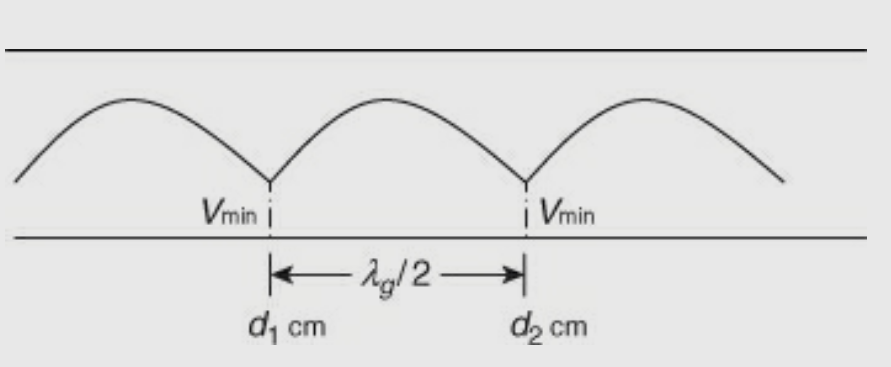
The distance between two successive voltage minima is given by
λg/2 = (d2 − d1).
The cutoff wavelength, λc = 2a (for the dominant TE10 mode), where “a” is the broad dimension of the waveguide Therefore,
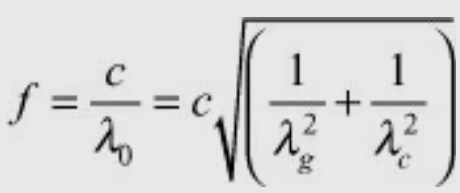
(where c - speed of light in free space (3 × l08 m/s)
f – frequency, (Hz)
λ 0 – wavelength in free space, (m)
λ g – wavelength of waveguide, (m)
λ c – cutoff wavelength of waveguide (m)
In this method, the guided wavelength (λg) in a waveguide is measured by creating standing waves in a slotted-line section. The distance between a maxima and minima of the standing wave (d2 – d1) corresponds to (λg/2); hence, frequency can be determined from the measurement of (λg).
Electronic Technique :
This method uses frequency heterodyne system. This system compares the unknown microwave frequency with a harmonic of the known standard frequency. The unknown frequency f can be calculated as below from the output frequency fand frequency nf by stating that,


Attenuators are used to adjust the power level of the microwave signal. If the network is perfectly matched, the reflected power is zero and the insertion loss is similar to the attenuation provided by the microwave device or component. Attenuation is defined as the ratio of input power to the output power in dB.

Where P1 = power detected by the load without the attenuator in the line, P2 = power detected by the load with the attenuator in the line.
Measurement of attenuation is done in two ways: (i) power ratio method; (ii) RF substitution method.
Power Ratio Method :

Power ratio method is a process of measuring the input and output power with the device (set up 1) and without the device (or attenuator) in the circuit. The P1 and P2 are the powers measured in setup 1 and 2. The attenuation is the ratio of power (P1/P2) which is expressed in decibels.
(a) Setup 1 power ratio method without the device or attenuator
(b) Setup 2 power ratio method with the device or attenuator
Disadvantage of the power ratio method : The attenuation calculated will not be accurate, particularly if it is large. Because the two powers measured (P1 & P2) is non-linear. It is also true for the networks with low input power. With this method, we can measure the attenuation up to 20 dB only.
RF Substitution Method :
The attenuation through the device under test is compared with a standard microwave attenuator operating at the same frequency in this method. The network whose attenuation is to be measured is included in the setup 1. Thus the output power “P ” is measured by this method. The drawbacks of the power ratio method can be overcome by this method as the attenuation is measured at a single power position. A precision calibrated variable attenuator replaces the network in setup 2. This attenuator is adjusted to get same output power “P,” as in setup 1. Under this condition, attenuation of the device is to be measured in the precision attenuator.

(a) Setup 1 RF substitution method
(b) Setup 2 RF substitution mathod
The noise factor or noise figure can be measured by using noise figure meters.
Noise factor is defined as the ratio of the actual output noise power of the device to the noise power that would be available if the device were perfect without itself contributing any noise and is expressed in decibels.
A noise source is used in the set up which has a constant output and can operate over a large bandwidth. The noise output from the device under test is noted by connecting its input to a matched termination . The input of the device is then connected to a standard noise source with a variable attenuator or pad. The pad is then adjusted till the noise output of the device is doubled. The noise factor of the device is then equal to the noise output of the attenuator[1]

———————————————— o ————————————————-
Reference Books:
- Microwave and Radar Engineering by M.Kulkarni , Umesh Publications.
- Foundations of Microwave Engineering by R.F.Collins , McGraw Hill.
- Microwave Principles by Reich et. Al. , Van Hestrand.
- Communication in Space by Jaffen , Halt Renetal Winston.
[1]